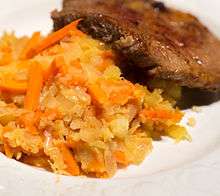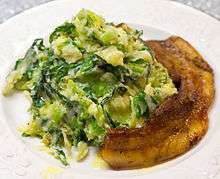Stamppot
|
| |
| Type | Side dish or Main course |
|---|---|
| Place of origin | Netherlands |
| Main ingredients | Potatoes, various vegetables and/or fruit |
| Variations | Hutspot, Wortelstoemp |
|
| |
Stamppot (English: Mash pot) is a traditional Dutch dish made from a combination of potatoes mashed with one or several other vegetables or fruits.
These vegetable pairings traditionally include sauerkraut, endive, kale, spinach, turnip greens, or carrot and onion (the combination of the latter two is known as hutspot in the Netherlands and as wortelstoemp in Belgium). Leafy greens such as endive may be left raw and added to the potatoes only at the mashing stage.[1] Some regional varieties of stamppot are made with fruit and potatoes, such as blauwe bliksem (blue lightning), made with pears, and hete bliksem (hot lightning), made with apples.[2] Pineapple may also be included in sauerkraut[3] or endive stamppot.[1]
Stamppot is usually served with sausage (in the Netherlands often smoked, in Belgium more often fried), julienned bacon, or stewed meat. Other accompaniments include cheese, gherkins, nuts or pickled onions.[1][2]
It is primarily a cold-weather dish, though some varieties are eaten year-round.[2]
Prepared stamppot can be purchased from shops and supermarkets. It can also be ordered in cafe-style restaurants, but more strict recent regulations about allowed foods in taverns versus restaurants has restricted the custom of offering simple dishes in many Belgian pubs.
The origin of stamppot is unknown, although legend attributes the invention of hutspot to 1574.[4] Using raw leafy vegetables instead of cooking them with the potatoes has not been dated to earlier than 1940.[5]
Making stamppot


There are two methods of preparing stamppot, the first being the more modern form:
- Stamppot is prepared by boiling the vegetables and potatoes separately. Once done, the potatoes are added to the same pot as the vegetables and all are thoroughly mashed together. Rookworst, a type of smoked sausage, is the preferred piece of meat to be added to the dish in the Netherlands.
- Stamppot can also be made in a single pot. Potatoes, onions, and the vegetable or fruit of choice are peeled and placed in the pot with the sausage. Water is added, and the mixture is left to boil. After the vegetables are cooked and drained, some milk, butter and salt are added, and the vegetables are mashed together. An example cooked by this method is hutspot.[6]
Lardons (spekjes) are often added for flavoring. It is also common to make a small hole in the top of the mix on the plate and fill it with gravy, known in Dutch as a kuiltje jus (little gravy pit).[6]
Similar dishes
- Biksemad, from Denmark
- Bubble and squeak, from England
- Champ, and Colcannon, from Ireland
- Rumbledethumps, from Scotland
- Roupa velha (Portuguese for "old clothes"), from Portugal, often made from leftovers from Cozido à Portuguesa
- Stoemp, from Belgium
- Trinxat, from the Empordà region of Catalonia, northeast Spain, and Andorra
References
- 1 2 3 "Andijviestamppot met ananas" [Endive stamppot with pineapple]. Recepten.net (in Dutch). Retrieved 12 October 2015.
- 1 2 3 Albala, Ken, ed. (2011). Food Cultures of the World Encyclopedia. Greenwood. p. 251. ISBN 978-0313376269. Retrieved 12 October 2015.
- ↑ "Zuurkoolstamppot met ananas" [Sauerkraut stamppot with pineapple]. Unox.nl (in Dutch). Retrieved 12 October 2015.
- ↑ "10 traditional Dutch recipes — not all of which involve potato". DutchNews.nl. 20 February 2015. Retrieved 12 October 2015.
- ↑ "Gezocht: vooroorlogse stamppot rauwe andijvie" [Seeking: pre-war recipes for stamppot with raw endive]. Historiek.net (in Dutch). Retrieved 12 October 2015.
- 1 2 Holten, Nicole (9 October 2010). "Boerenkool met worst". TheDutchTable.com. Retrieved 11 October 2015.
- Bates, J (1988). Let's Go Dutch, van der Zeijst Publishing, pp. 83-84
| Wikimedia Commons has media related to Stamppot. |
